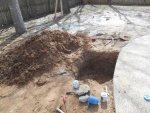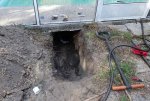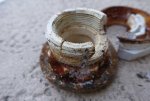Hi everyone!
I have an inground vinyl pool with 2 return inlets on one return line. I've had a small leak for a while now and it seems be getting worse. I know the leak is in the return line because a local pool company helped me find it by pressure testing and listening with a "big ear" on the pool deck, but I'm only now getting around to pinpointing exactly where it is. Today I dug under the side of the pool deck praying the leak was at the elbow heading toward the pool. Nope, unfortunately it appears the leak is at the actual return inlet fitting. I haven't dug far enough to get a visual confirmation, but the water was flowing pretty good through the dirt from the direction of the return inlet.
So, now I need to figure out how to replace that fitting and not die from claustrophobia crawling under the pool deck. This looks like what I've got (just based on the looks of the inside of the pool): Hayward SP1408 Amazon.com: Hayward SP1408 In-Ground Swimming Pool Return Inlet Fitting: Patio, Lawn Garden It appears that this attaches to the pool wall and is held in place by the collar ring. Here are my concerns/questions:
1. There's now way to replace this from inside the pool without crawling under the pool deck? By the looks of it, I'm guessing not.
2. How do I attach this fitting to behind the vinyl? Do I have to remove the vinyl from the coping and hope I can get it back in the track? How do I do this? Special tools?
3. Do all IG vinyl pools have rigid walls? When I feel the wall from inside the pool, it seems soft and earthy like it's pressed against dirt. Is it possible that there's no wall outside of the vinyl?
4. Once the fitting is replaced, is this the right part to get it connected to the return line? Shop LASCO 1-1/2-in Dia PVC Sch 40 Adapter at Lowes.com Should I use thread tape or glue?
5. Any tricks for digging and crawling under pool decks? It seems horrible.
I never got a quote from a pool builder to fix this, but I'm wondering if I should. I'm pretty handy, but this seems like a true pain in the butt.
Anyway, thanks for any input!
- Damian
I have an inground vinyl pool with 2 return inlets on one return line. I've had a small leak for a while now and it seems be getting worse. I know the leak is in the return line because a local pool company helped me find it by pressure testing and listening with a "big ear" on the pool deck, but I'm only now getting around to pinpointing exactly where it is. Today I dug under the side of the pool deck praying the leak was at the elbow heading toward the pool. Nope, unfortunately it appears the leak is at the actual return inlet fitting. I haven't dug far enough to get a visual confirmation, but the water was flowing pretty good through the dirt from the direction of the return inlet.
So, now I need to figure out how to replace that fitting and not die from claustrophobia crawling under the pool deck. This looks like what I've got (just based on the looks of the inside of the pool): Hayward SP1408 Amazon.com: Hayward SP1408 In-Ground Swimming Pool Return Inlet Fitting: Patio, Lawn Garden It appears that this attaches to the pool wall and is held in place by the collar ring. Here are my concerns/questions:
1. There's now way to replace this from inside the pool without crawling under the pool deck? By the looks of it, I'm guessing not.
2. How do I attach this fitting to behind the vinyl? Do I have to remove the vinyl from the coping and hope I can get it back in the track? How do I do this? Special tools?
3. Do all IG vinyl pools have rigid walls? When I feel the wall from inside the pool, it seems soft and earthy like it's pressed against dirt. Is it possible that there's no wall outside of the vinyl?
4. Once the fitting is replaced, is this the right part to get it connected to the return line? Shop LASCO 1-1/2-in Dia PVC Sch 40 Adapter at Lowes.com Should I use thread tape or glue?
5. Any tricks for digging and crawling under pool decks? It seems horrible.
I never got a quote from a pool builder to fix this, but I'm wondering if I should. I'm pretty handy, but this seems like a true pain in the butt.
Anyway, thanks for any input!
- Damian







